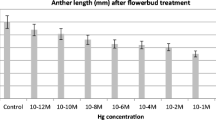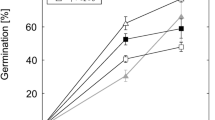Summary
Pollen tubes ofLilium longiflorum growingin vitro were treated for 1 h with inorganic lead (Pb) and with triethyl lead (TriEL) and studied by light and electron microscopy. Pb was considerably more toxic in relation to inhibition of pollen tube growth (EC50=6 μM Pb) than was TriEL (EC50=60 μM TriEL). On the other hand, at almost the entire concentration range tested (25-500 μM) TriEL caused aberrant tubes and tube swellings. Pb did not cause tube swellings, even at highly growth-impairing concentrations. Pb (60 μM) predominantly affected the ultrastructure of the growing cell walls without impairing the distribution of the cell organelles in the tube tips. In contrast, 50 and 100 μM TriEL did not visibly influence cell wall ultrastructure but it severely damaged dictyosomes; 100 μM TriEL also disturbed the original order of cell organelles in the tube tips. Cortical microtubules were selectively and completely destructed by TriEL at concentrations (50 μM) where no effect on polar organization of the tube tips occurred but they remained unimpaired by 60 μM Pb, indicating selective and effective interaction of TriEL with these cell organelles.
Similar content being viewed by others
Abbreviations
- EC50 :
-
effective lead concentration causing 50% inhibition of pollen tube growth
- MTs:
-
microtubules
- Pb:
-
inorganic lead
- TriAL:
-
trialkyl lead
- TriEL:
-
triethyl lead
References
Ahlberg J, Ramel C, Wachtmeister CA (1972) Organolead compounds shown to be genetically active. Ambio 1: 29–31
Cremer JE (1959) Biochemical studies on the toxicity of tetraethyl lead and other organo-lead compounds. Br J Industr Med 16: 191–199
Cresti M, Pacini E, Ciampolini E, Sarfatti G (1977) Germination and early tube developmentin vitro ofLycopersicum peruvianum pollen: ultrastructural features. Planta 136: 239–247
De Jonghe WRA, Chakraborti D, Adams F (1981) Identification and determination of individual tetraalkyl lead species in air. Environ Sci Technol 15: 1217–1222
—,Van Mol WE, Adams F (1983) Occurrence and fate of organic lead compounds in the hydrosphere. In: Proc Int Conf Heavy Metals in the Environment. Heidelberg. CEP Consultants. Edinburgh, pp 166–169
Faulstich H, Stournaras C (1985) Potentially toxic concentrations of triethyl lead in Black Forest rainwater samples. Nature 317: 714–715
Franke WW, Herth W, Van der Woude WJ, Morre DJ (1972) Tubular and filamentous structures in pollen tubes: Possible involvement as guide elements in protoplasmic streaming and vectorial migration of secretory vesicles. Planta 105: 317–341
Grandjean P (1984) Organolead exposures and intoxications. In:Grandjean P (ed) Biological effects of organolead compounds. CRC Press, Boca Raton, Florida, pp 227–241
Hager A, Moser I, Berthold W (1987) Organolead toxicity in plants: triethyl lead (Et3 Pb+) acts as a powerful transmembrane Cl−/OH− exchange dissipating H+-gradients at nano-molar levels. Z Naturforsch 42c: 1116–1120
Harrison RM, Perry R (1977) The analysis of tetraalkyl-lead compounds and their significance as urban air pollutants. Atmos Environ 11: 847–852
Hensel W (1986) Cytodifferentiation of polar plant cells. Use of anti-microtubular agents during the differentiation of statocytes from cress roots (Lepidium sativum L.) Planta 169: 293–303
Herth W, Franke WW, Bittiger H, Kuppel A, Keilich G (1974) Alkali-resistant fibrils of ß-1,3- and ß-l,4-glucans: Structural polysaccharides in the pollen tube wall ofLilium longiflorum. Cytobiol 9: 344–367
Heumann HG (1987) Effects of heavy metals on growth and ultrastructure ofChara vulgaris. Protoplasma 136: 37–48
Kutschera U, Bergfeld R, Schopfer P (1987) Cooperation of epidermis and inner tissues in auxin-mediated growth of maize coleoptiles. Planta 170: 168–180
Morré DJ, Boss WF, Grimes H, Mollenhauer HH (1983) Kinetics of Golgi apparatus membrane flux following monensin treatment of embryonic carrot cells. Eur J Cell Biol 30: 25–32
Reiss HD, Herth W (1979) Calcium ionophore A-23187 affects localized wall secretion in the tip region of pollen tubes ofLilium longiflorum. Planta 145: 225–232
— — (1980) Effects of the broad-range ionophore X-537 A on pollen tubes ofLilium longiflorum. Planta 147: 295–301
— — (1982) Disoriented growth of pollen tubes ofLilium longiflorum Thunb. induced by prolonged treatment with the calciumchelating antibiotic, chlorotetracycline. Planta 156: 218–225
— —,Schnepf E (1985) Plasma-membrane “rosettes” are present in the lily pollen tube. Naturwiss 71: 276
- - - (1986) Calcium and polarity in tip growing plant cells. In:Trewavas AJ (ed) Molecular and cellular aspects of calcium in plant development. NATO ASI Series, Series A 104: pp 211–217
—,Traxel K (1987) Hint of polar distribution in calcium channels under PIXE analysis. Biol Trace Element Res 13: 135–142
Röderer G (1981) On the toxic effects of tetraethyl lead and its derivatives on the chrysophytePoterioochromonas malhamensis. II. Triethyl lead, diethyl lead, and inorganic lead. Environ Res 25: 371–384
— (1982) On the toxic effects of tetraethyl lead and its derivatives on the chrysophytePoterioochromonas malhamensis. III. Chemical analyses. J Environ Sci Health A 17: 1–20
— (1984 a) Toxic effects on plant organisms. In:Grandjean P (ed) Biological effects of organolead compounds. CRC Press, Boca Raton, Florida, pp 63–95
- (1984 b) Different physiocochemical and toxic properties of inorganic and organic (alkylated) compounds of lead. In: Abstr Int Symp Bioavailability of Environmental Chemicals. September 1984, Schmallenberg-Grafschaft, p 9
— (1986) On the toxic effects of tetraethyl lead and its derivatives on the chrysophytePoterioochromonas malhamensis. VII. Protective action of thiol compounds, vitamins, trace elements and other agents. Ecotox Env Safety 11: 277–294
— (1986) On the toxic effects of tetraethyl lead and its derivatives on the chrysophytePoterioochromonas malhamensis. VI. Effects on lorica formation, mitosis and cytokinesis. Environ Res 39: 205–231
—,Doenges KH (1983) Influence of trimethyl lead and inorganic lead on thein vitro assembly of microtubules from mammalian brain. Neurotoxicology 4: 171–180
Schnepf E (1986) Cellular polarity. Ann Rev Plant Physiol 37: 23–47
Simons TJB (1986) Cellular interactions between lead and calcium. Br Med Bull 42: 431–434
Tepfer M, Taylor IEP (1981) The interaction of divalent cations with pectic substances and their influence on acid-induced cell wall loosening. Can J Bot 59: 1522–1525
Unsworth MH, Harrison RM (1985) Is lead killing German forests? Nature 317: 674
Van der Woude WJ, Morré DJ, Bracker CE (1971) Isolation and characterization of secretory vesicles in germinated pollen ofLilium longiflorum. J Cell Biol 8: 331–351
Zimmermann HP, Doenges KH, Röderer G (1985) Interaction of triethyl lead chloride with microtubulesin vitro and in mammalian cells. Exp Cell Res 156: 140–152
Author information
Authors and Affiliations
Rights and permissions
About this article
Cite this article
Röderer, G., Reiss, H.D. Different effects of inorganic and triethyl lead on growth and ultrastructure of lily pollen tubes. Protoplasma 144, 101–109 (1988). https://doi.org/10.1007/BF01637242
Received:
Accepted:
Issue Date:
DOI: https://doi.org/10.1007/BF01637242




